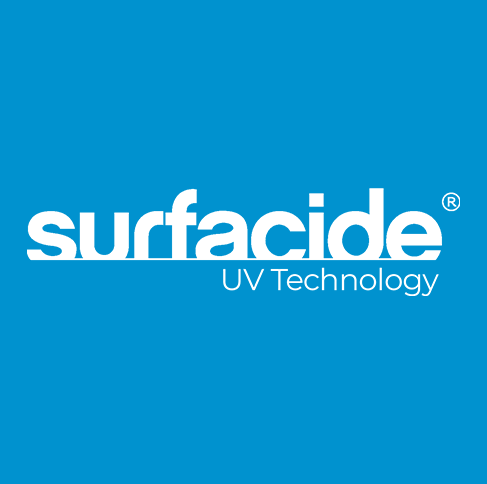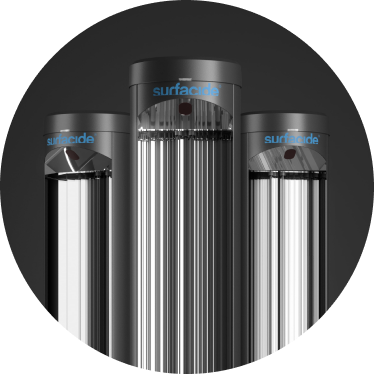Frequently Asked Questions
What is UV-C Light?
UV Light, or Ultraviolet light, is made up of three wavelengths of light: UVA, UVB, and UVC.
The longest wavelength, UVA, is everywhere, able to penetrate the atmosphere, and makes up 95% of all the UV rays from the sun. This type of UV light can cause sunburns, skin aging, and even skin cancer. UVB is the second longest wavelength and, even though it is mostly absorbed by the ozone layer, it can still be harmful to humans. The shortest wavelength, UVC, is unable to penetrate the Earth’s atmosphere and is fully absorbed by the ozone layer.
Surfacide UV technology utilizes the UVC wavelength, which measures from 0 to 280 nanometers. Optimal UV light disinfection or its peak germicidal UVC wavelength is 254nm.
No person should be directly exposed to UV-C light. However, following proper safety protocols, Surfacide UVC lights can be operated safely. Surfacide also incorporates safety motion sensors that are placed on the entryways of the areas being disinfected to avoid unintended exposure to UV-C light.
What is UVC disinfection and how does it work?
UVC disinfection is an evidence-based method of using UV-C light to inactivate or kill vegetative forms of bacteria, some fungi, and lipid viruses. UV-C light causes damage to the nucleic acid of microorganisms by forming covalent bonds between certain adjacent bases in the DNA and RNA. The formation of such bonds prevents the DNA and RNA from being unzipped for replication, and the organism is unable to reproduce. In essence, it destroys the molecular bonds that hold their DNA together.
Surfacide UV technology is designed to disinfect non-porous surfaces as an adjunct to existing, manual cleaning practices (and is not a replacement for or modification to such practices).
Is UVC disinfection safe?
UVC disinfection is generally safe when used properly by trained professionals. It is recommended for unoccupied environments where all points of entry are closed and secured with safety motion sensors and caution signs.
To ensure proper use, all operators are trained and certified by a Surfacide Implementation Specialist or a designated super user. The Surfacide UV technology tablet application incorporates a safety checklist that must be completed prior to operation of the Helios UV system. Safety motion sensors are also used to detect entry into a disinfection area. When triggered, the sensor turns off the UV light and the operator is notified via the tablet that the disinfection cycle was paused.
Is UVC technology eco-friendly?
UVC disinfection is a green technology and sustainable in the following ways:
- Free of chemicals
- No harmful emissions or byproducts
- Reusable
Surfacide UV technology is designed to optimize UVC output and consumes less power than many other single-light tower systems. Additionally, Surfacide recommends and will assist with recycling lamps after their useful life.
What types of environments benefit from UVC disinfection?
UVC disinfection has its roots in healthcare but is a versatile technology that can benefit a wide range of environments.
Surfacide UV technology is trusted in more than 1,000 locations around the world. With various payment options and subscription plans, some of the key settings where Helios are used include:
- Healthcare facilities, both acute and non-acute including hospitals, senior living, or rehabilitation centers
- Dental practices
- Hospitality, hotels, or resorts
- School systems
- Pharmacy or sterile compounding rooms
- Tourist or entertainment areas like the Seattle Space Needle or Fenway Park
- Government or City facilities such as fire or police stations
How long does UV-C light take to disinfect?
Time varies depending on the size of the room and the objects in it. The closer the UV-C light tower is to the surface to be disinfected, the less time it will take. UVC intensity (irradiance) from the emitter is constant, however, as the distance from the source increases, the intensity decreases by the inverse of its square. Since UV-C light is a direct line of sight technology, multiple lines of sight reduce shadows by reaching more surfaces.
The Surfacide Helios UVC disinfection system uses three UVC emitters to deliver more energy in in less time. With each robot able to disinfect nonporous surfaces in up to a 7 foot radius, utilizing multiple robots eliminates the need for repositioning a single robot and results in a more efficient UVC disinfection cycle.
What is the smell after a UVC disinfection cycle?
During initial disinfection cycles, the lamp filament or adhesive may release a slight odor. This is the oxidation of microscopic organic matter, such as dust. The smell is not harmful and typically dissapates in 5 to 10 minutes after the cycle is completed. It is safe to enter the space immediately after the cycle completes.
Is it easy to transport the UV-C light emitters?
Yes, Surfacide’s three UVC emitters are easy to move throughout your space. The feet of the two provided caution signs are also used to conjoin the emitters for transport. Once conjoined in a row, simply grip the halos and walk alongside.
The force required to start moving are:
| Units lbf | 1 emitter | 2 emitters | 3 emitter |
| Smooth, hard floor | 1-3 lbf | 2-6 lbf | 2-10 lbf |
| Berber carpet | 2-6 lbf | 5-11 lbf | 7-27 lbf |
(range in values is due to caster orientation)
Can I be exposed to UVC through glass, walls, doors, or fabrics?
No, UVC does not breach walls, door, or fabrics. However, at high doses, it may cause a discoloration and degradation of materials, specifically certain plastics. Normal glass blocks UV wavelengths shorter than 330 nm, which includes Surfacide UVC at 254 nm.

